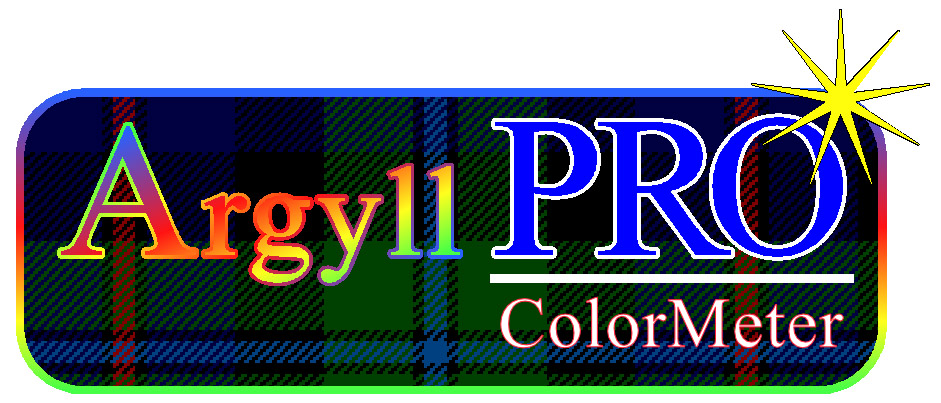
ColorMeter Version 2 now released!
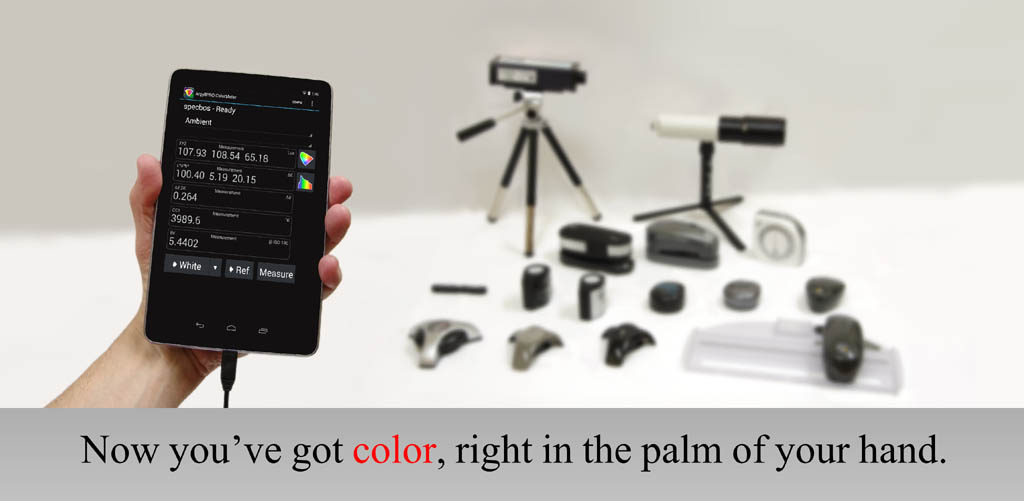
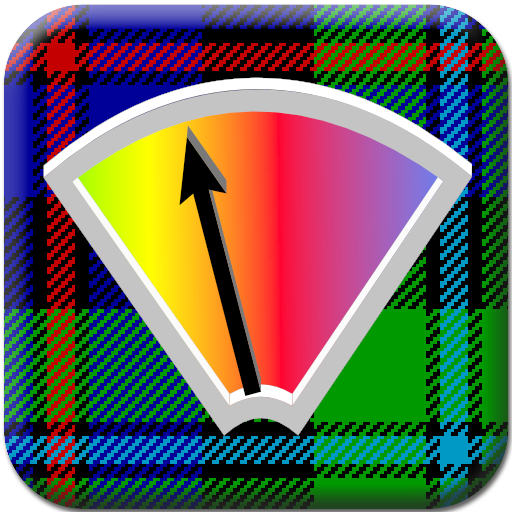 ArgyllPRO ColorMeter is an
innovative handheld application designed for both Tablets and
Phones, that lets you use all your USB connected color measurement
instruments on the go, as well as save them for use later. The
popular color instruments supported can be used for a wide range of
common light and color measurement tasks, so ColorMeter
provides a great deal of flexibility and configurability, allowing
you to customize it to the task at hand and switch tasks rapidly. It
can also use a ChromCast as a compact Video Test Pattern Generator.
Of interest to Designers, Graphic Artists, Photographers,
Architectural and Theater Lighting Designers, Printing
Professionals, Colorists, Film professionals and TV & Digital
Cinema calibrators.
ArgyllPRO ColorMeter is an
innovative handheld application designed for both Tablets and
Phones, that lets you use all your USB connected color measurement
instruments on the go, as well as save them for use later. The
popular color instruments supported can be used for a wide range of
common light and color measurement tasks, so ColorMeter
provides a great deal of flexibility and configurability, allowing
you to customize it to the task at hand and switch tasks rapidly. It
can also use a ChromCast as a compact Video Test Pattern Generator.
Of interest to Designers, Graphic Artists, Photographers,
Architectural and Theater Lighting Designers, Printing
Professionals, Colorists, Film professionals and TV & Digital
Cinema calibrators.
Use your X-Rite Eye-One Display Pro to make accurate measurements of
ambient, spot or display light levels and color temperature for
Photography or Lighting design. Measure and calibrate Televisions
and Projectors using a Klein K10-A. Check print samples using your
ColorMunki spectrometer or Eye-One Pro 2 in the field. Obtain
accurate sample measurements to incorporate into your documents or
web pages, and find the closest matching color swatch instantly.
Check movie theater certification using a JETI specbos 1211 -
ArgyllPRO ColorMeter has you covered. A tool you'll want to have in
your color arsenal.
Check out the 2 Minute
Overview + Guided Tour Video
Please visit the Google Play store to install the ColorMeterDEMO
(free), or ColorMeter
applications.
New in Version 2.0:
- i1Pro 3 and i1Pro 3 Plus support
- Measurement Export
- Measurement logging for later review & Export
- Compatible with Android 11 Scoped Storage limitations
Why Android ? - because it's the only portable platform that gives
applications ready access to a USB host port - something essential
to being able to use accurate, readily available color measurement
instruments. The fact that it's the largest open platform for mobile
applications, and as well as being available in a wide range of form
factors and price points, adds to its attraction.
Not all Android devices will be able to run ColorMeter, although the
situation is improving all the time with the introduction of newer
Android based products. You need to be running Android version 4.0
(Ice Cream Sandwich) or latter, and your Android device needs a
functional USB on the go (USB OTG) port to connect to most
instruments, or Bluetooth to connect to Blutetooth capable
instruments. Before purchasing
ArgyllPRO ColorMeter or an Android device capable of working with
your instruments, it is highly recommended that you
explore ColorMeter's capabilities, and check that it is going to
work with your hardware, by downloading and running the free
ArgyllPRO ColorMeterDEMO
application. See the FAQ below for more information on
choosing an Android device and/or Color measurement Instrument.
Capabilities:
Tri-stimulus & Spectral measurement in Emissive,
Ambient, Reflective, Transmissive & Flash measurement modes.
Display Refresh rate.
Chromaticity and Spectral graphic display.
Configurable readouts of any measurement combination.
Current measurement, reference measurement and White, Black, Red,
Yellow, Green Cyan, Blue and Magenta Primary measurement
registers.
- CIE XYZ based tri-stimulus colorspaces: XYZ, Yxy, Yu'v',
L*a*b*, L*C*h*ab, L*u*v*, L*C*h*uv &
DIN99 Lab.
- Component differences between the Reference and the
Measurement CIE XYZ based tri-stimulus colorspaces.
- Delta E between Reference and the Measurement: CIE Delta E
76, CIE Delta E 94,CIE Delta E 94 Textile, IE Delta E 2000,
CMC Delta E 2:1, CMC Delta E 1:1, DIN99 Delta E.
- Density: Visual Density, Status A Density, Status M Density,
Status T Density, Status E (DIN) Density, ISO Type 1 & 2
Density.
- Photography specific: Incident illuminance, reflected
luminance, flash measurement, Exposure Value (EV), Interactive
Exposure Calculator.
- Color Temperature, Delta Color Temperature, Black Body or
Daylight, Correlated or DE2000, Kelvin or Mired.
- Configurable RGB colorspace including BT.709, BT.2020,
DCI-P3, custom, BT.1886, Delta RGB, RGB or CMY Adjustment
Direction.
- Color Rendering Index (CIE 1995 Ra + R9), Television
Lighting Consistency Index (EBU TLCI-2012 Qa), IES TM-30-15
Light Source Color Rendition.
- Visual Contrast
- ARPANSA UV Exposure
- Web RGB, Visual Compare Swatches, Named Color, Named Color
Visual Swatch, with installable CxF or ICC Palettes.
Save and Restore ColorMeter and Instrument configurations.
Download & install display calibrations, named color palettes
& OEM instrument support files.
Export measurements in .TSV (Tab Separated Value) format, as well
as ArgyllCMS .sp format.
Save up to 10000 measurements for later review and/or exporting.
Full documentation accessible directly from the application.
Instruments supported:
- JETI specbos: 1211 & 1201, spectraval 1511 & 1501.
- Image Engineering EX1
- Klein: K1, K8, K10, K10-A
- X-Rite & Calibrite: DTP20, DTP94, ColorMunki Design,
Photo or i1Studio or ColorChecker Studio, ColorMunki Create or
Smile, Eye-One Display Pro, ColorMunki Display, Calibrite
ColorChecker Display/Pro/Plus, OEM i1d3 instruments, Eye-One
Pro2, Eye-One Pro3, Eye-One Pro3 Plus
- Gretag-Macbeth: Eye-One Pro, Eye-One Monitor, Eye-One
Display 1 or 2 or LT, HP DreamColor or APS, CalMAN X2,
Huey
- Sequel Imaging: MonacoOPTIX
- Lacie Blue Eye
- DataColor: Spyder 2, Spyder 3, Spyder 4, Spyder 5 &
SpyderX
- SwatchMate Cube, with improved color accuracy.
Video Test Pattern Generator (TPG) Capability:
By making use of a ChromeCast, ColorMeter can act as
an HDMI Video Test Patch and Test Card source. While the
ChromeCast is not a bit perfect TPG, the use of dithering makes
it accurate to within perceptual limits. There is no support for
switching to HDR mode in software.
It can be used to display one of six standard Test Cards,
covering Display geometry, Probe locations, Low clipping, High
clipping, Neutrals and Color ramps. It can also be used to
display a test patch color that matches the reference RGB value
Readout, which combined with continuous measurement mode and
Delta E and RGB adjustment Readouts, gives color by color Video
calibration capability.
It will work with Chromecast 1, Chromecast 2, Chromecast Ultra
and Chromecast with Google TV. It almost certainly works with
Chromecast 3.
System Requirements:
- USB On The Go (OTG) capable Android
tablet or phone.
- Recommended screen size of 94 mm (3.7
inches) or greater.
- Android V4.0 (Ice Cream Sandwich) or
later.
- Must be running Google Play Store
services.
- USB OTG adapter lead.
- Bluetooth for connecting to JETI
spectraval 1511 & 1501 wirelessly, BlueTooth LE for
connecting with SwatchMate Cube wirelessly.
The exact capabilities depend on the type of instrument you are
using.
For more detail, please explore the on-line documentation
as well as the 2
Minute Overview + Guided Tour Video.
Preset Configurations provided:
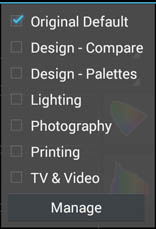
Example configurations:
Printing
|
Photography
|
Lighting
|
Graphic Design |
TV & Video
|
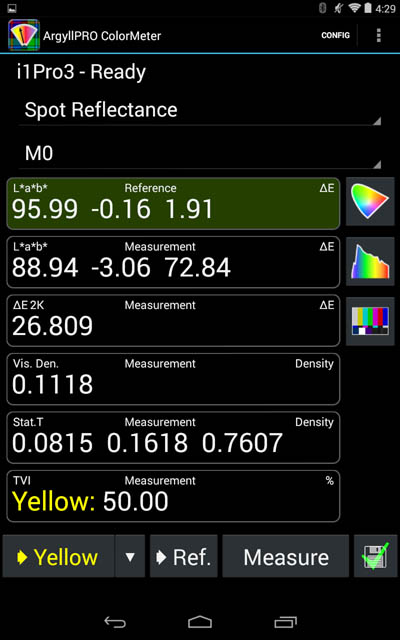 |
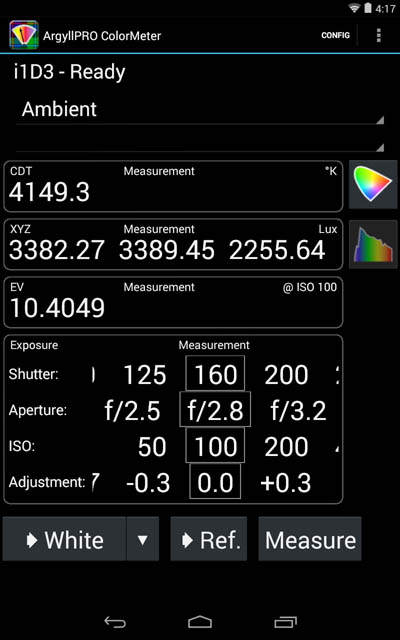 |
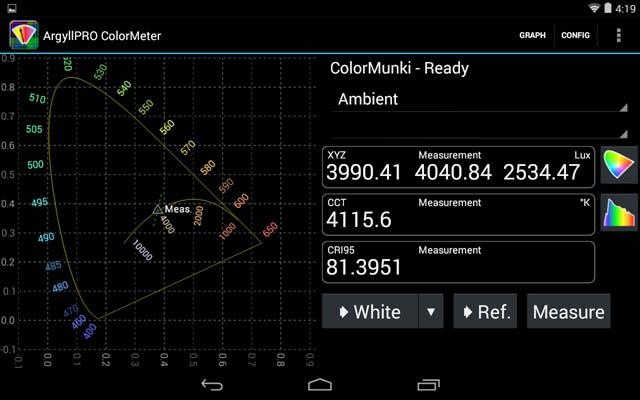 |
|
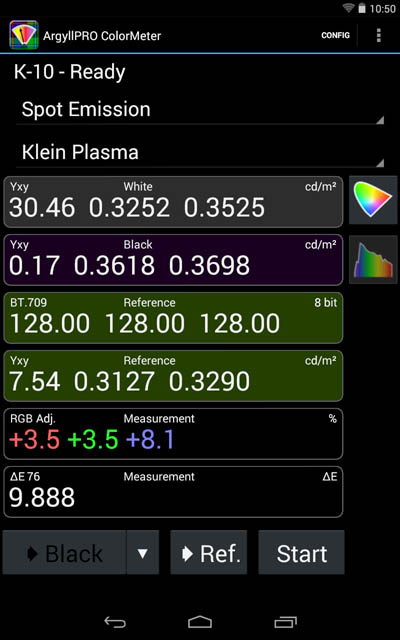 |
Video Test Cards:
| Geometry |
Probe Locations
|
Low Clipping
|
High Clipping
|
Neutrals
|
Color Ramps
|

|
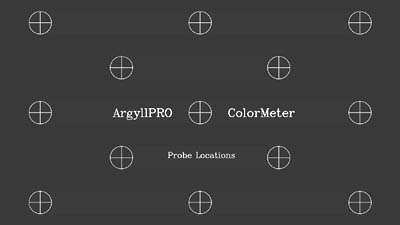
|
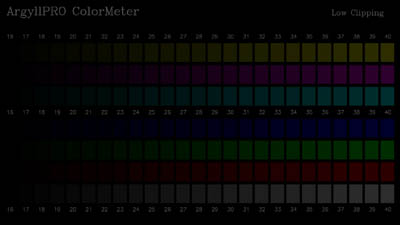
|
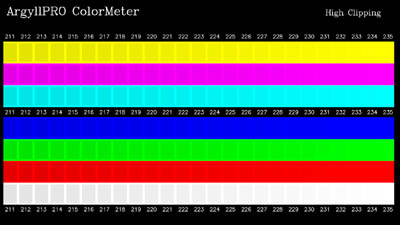
|
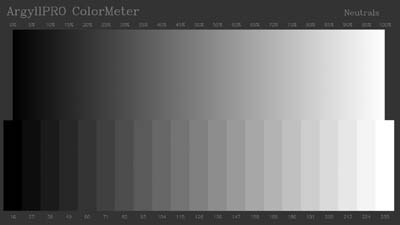
|
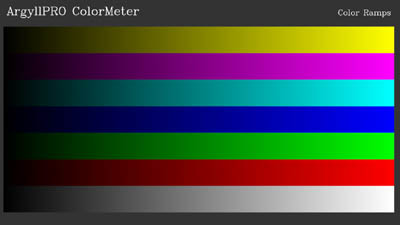
|
Export to spreadsheet:

Cost:
Price of AU$ 150 ( + GST if applicable) from the Google Play Store.
(Approx. US$99)
Availability:
Please visit the Google Play store to install the ColorMeterDEMO
(free), or ColorMeter
applications.
If you have trouble getting your instrument to work with
ColorMeterDEMO when you expect it should work, or are having other
difficulties running the software on a particular Android platform
and are prepared to help a little in figuring out why, please
contact support@argyllpro.com.au.
Required Accessories:
For Android devices with a micro USB port, you'll need a USB
OTG ("On The Go", or Host Adaptor) lead (technically a micro-B USB
2.0 OTG to female Type A) - for any instrument. Simply plug the
instruments normal USB male Type A plug into the OTG lead. Some
examples here.
They typically look something like this:
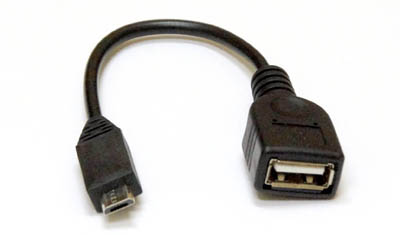
They are becoming widely available at stores that sell Phone and
Tablet accessories (e.g. RadioShack seem to stock them [Model:
2604173], Belkin make one [P/N:
F2CU014btBLK ], etc., so
it's worth asking at such a store, and showing them a picture of
one), as well as on-line. (I have had some trouble with one adapter
that has a plug that is slightly too short to reliably plug into my
Android device.)
To get a reliable connection, it is typically best to plug the
instrument into the OTG cable, and then plug the
OTG cable into your Android device. Doing it in the reverse
order can often mean that the instrument won't be recognized.
If your Android device has a USB C port, then you will need
a USB C to USB 2.0 female Type A adapter. These are widely available
as accessories for USB C equipped devices. Using USB C, it seems to
be more reliable to plug the OTG cable into your Android device
and then plug the instrument into the Adapter cable.
This is the reverse of the OTG cable!
It may also help to turn the USB C plug over if you are having
trouble.
If you are using the JETI spectraval 1511 or 1501 and your Android
Device supports Bluetooth, or SwatchMate Cube and your Android
device supports BlueToothLE, then you can use Bluetooth instead of
USB.
End User License Agreement:
You can preview the EULA here.
Note that if you purchase ColorMeter and are satisfied with it, but
at some later stage change your Android device to one that is unable
to run it, then there is no obligation to offer refunds.
Android
Features and Permissions:
The following Android features may be requested by the
application:
android.hardware.usb.host
Required by ColorMeter,
used if available by ColorMeterDemo.
android.hardware.camera
For logging
a photo for each measurement.
android.hardware.bluetooth_le
To be able to access SwatchMate Cube Bluetooth LE and JETI
Spectraval BT.
The following Android permissions may be requested by the
application:
android.permission.WRITE_EXTERNAL_STORAGE
android.permission.READ_EXTERNAL_STORAGE
android.permission.WRITE_INTERNAL_STORAGE
android.permission.READ_INTERNAL_STORAGE
To be able to load setup files and save configuration state.
android.permission.BLUETOOTH
android.permission.BLUETOOTH_ADMIN
android.permission.BLUETOOTH_SCAN
android.permission.BLUETOOTH_CONNECT
android.permission.ACCESS_COARSE_LOCATION
To be able to access SwatchMate Cube Bluetooth LE and JETI
Spectraval BT.
android.permission.WAKE_LOCK
To workaround issue 38191: Device won't wake from sleep with USB
device plugged on Android < V4.4
android.permission.READ_LOGS
To be able to gather debug logging and allow user to email it to
ArgyllPRO on Android < V4.1
android.permission.INTERNET
For Video Test Pattern Generator & Debug ViewServer
android.permission.CHANGE_WIFI_MULTICAST_STATE
For locating OEM download server using mDNS/ZeroConf.
android.permission.ACCESS_FINE_LOCATION
To be able to log the location a measurement was made.
Change Log:
A list of all the major updates for each release is here.
Support & feedback:
Support is via the colormeterlist mailing list. To
subscribe, go to the colormeterlist
mail manager.
[ This list is for ColorMeter related discussions - please direct ArgyllCMS
questions to the ArgyllCMS mailing
list. ]
Mail to colormeter@argyllpro.com.au and support@argyllpro.com.au
will be responded to on an "as available" basis, and in most cases a
speedier response can be expected from the mailing list.
Feedback, suggestions and comments are welcome.
FAQ:
Q: Will there be an
iPod/iPhone/iPad version ?
A: Unfortunately this is
unlikely, since (as explained above), the ColorMeter application
depends on access to a USB host port on the device, and iOS devices
have neither a USB port, nor are applications allowed to directly
access a USB port using any readily available USB host adapter.
Until Apple changes its policy in this regard, there can be no
version of ColorMeter for iOS. If you think you would find
ColorMeter useful, then the most pragmatic solution at present is to
buy an Android device that will run it. Such devices are becoming
cheaper and more readily available all the time.
Q: Will it run on a BlackBerry
using "Runtime for Android" ?
A: Unfortunately there are
two limitations of Runtime for Android that prevent this from being
possible. One is that it doesn't support USB OTG connectivity. The
other is that it doesn't support Android NDK libraries, and
ColorMeter relies on a native library for its instrument driver
code.
Q: What Android Tablet would you recommend ?
A: I can highly recommend the Nexus 7 (new or second
hand), as it work with all USB instruments and has battery capacity
to power them, as well as a very useful display size while still
being small enough to comfortably hold in one hand.
The Nexus 7 has become hard to get now, and one other 7" device that
I have tested with all the instruments is the Lenovo TAB3 7
Essential. The positives about this tablet is that 1) it works
with all the instruments and 2) it's cheap. Disadvantages are 1)
it's display is lower resolution and has an incorrect aspect ratio
and 2) it's battery performance when sleeping isn't great. Another
tablet that works well is the Samsung Galaxy Tab A 8 (2017).
Other, tablets and phones featuring Android V4 and USB OTG support,
and therefore potentially able to run ColorMeter, are also widely
available.
Note that a number of people have reported problems with
using some Samsung models (Galaxy S3, Galaxy Tab 3, Galaxy
Note 2 and others) in combination with the ColorMunki
spectrometer. This may be due to a bug in Samsungs USB host hardware
or driver, and so may depend on which version of Android it is
running.
Here is a list of the Android devices
that existing customers are using, but the safest thing is to try
out a tablet or phone using ColorMeter Demo, to make sure it will
work with your instrument, before you buy it.
Q: What instrument would you recommend ?
A: This very much depends on what you want to measure, and
your budget.
- For low cost light level and emissive, ambient and display
color measurement, it's hard to go past the X-Rite
i1 DisplayPro or ColorMunki Display colorimeters.
- For entry level display measurement, the Spyder
4 is another choice.
- To make reflective measurements at the absolute lowest cost
(but with very limited accuracy), the SwatchMate
Cube may be appropriate.
- For a versatile and relatively low cost spectral measurements,
the X-Rite
ColorMunki Design or Photo is hard to beat. This
combination is great for graphic arts and photography use.
- A higher end general purpose spectrometer that can be used is
the X-Rite
Eye-One Pro2.
- For high speed and high accuracy display measurement, the Klein
K10-A Colorimeter would be the ideal choice.
- For the most accurate spectral emissive, ambient and display
measurements, then specbos
1211 and 1201 Tele-Spectro-Radiometer is the right
instrument, or a spectraval
1511 or 1501 if ambient measurement is not needed.
Q: My i1pro2 doesn't work! - I get an error during
reflective calibration and/or measurement!
A: One of the things many people have noticed about X-Rite's
i1pro2, is that it is very sensitive to the USB lead length and
quality. This is probably an issue with the power being supplied
over USB to the instrument, and X-Rite having made it very
particular about the voltage level. This manifests itself as a
problem whenever the measurement light gets turned on, often during
calibration. One solution is to try using a shorter (but high
quality) USB lead, say around 1 Meter (3 feet) in length. A short
lead often makes the whole arrangement more convenient to use in a
hand-held configuration anyway. Another solution that may work if
this problem has just started after successfully using the
instrument, is to use some electrical contact cleaner spray on the
USB connectors, as high resistance due to dirt and contact wear can
trigger the problem. Some Android devices may not be able to supply
sufficient power to the reflective measuring instruments, or may
have a poor USB voltage level, making them unsuitable for use with
the i1pro2.
Q: My i1pro2/i1pro3 doesn't work reliably! -
Sometimes it fails to initialize after plugging in.
A: Some of the instruments are more sensitive to supplied
USB voltage than others, and different Android devices are better or
worse at supplying the correct USB voltage. My Samsung Galaxy Tab A
had a strange fault with an earlier version of Android in which
2/3's of the time that you plugged in the OTG adapter, it would
supply 4.3 Volts and the i1Pro2 and i1Pro3 would fail to initialize.
1/3 of the time it would supply the correct 5 Volts and the
instruments would work. Upgrading to Android 9 cured this problem.
So if you are noticing unreliable spectrometer behavior, suspect
leads, OTG adapters, under-spec. Android hardware and even bugs in
Android USB drivers.
Q: When I plug an instrument or other USB OTG device in,
nothing happens. How can I fix this ?
A: Either your Android device doesn't support USB OTG, or it
is not enabled. For instance, the Sony Z5 has a "detect usb" button
in the notifications panel that should be turned on.
Q: Is ColorMeter available
in any languages other than English ?
A: At the present time, no.
CGTPL is a small company, and currently does not have the resources
to provide a fully internationalized product.




















